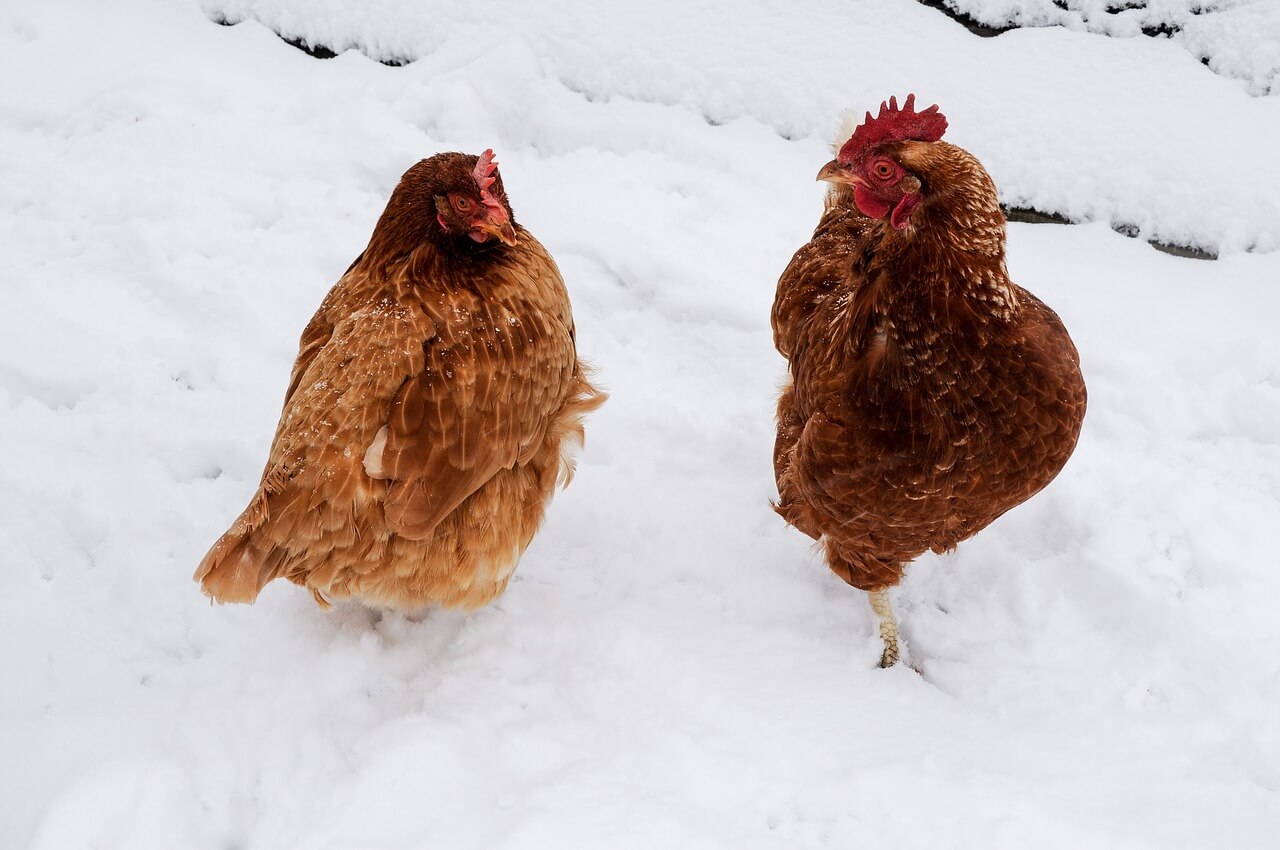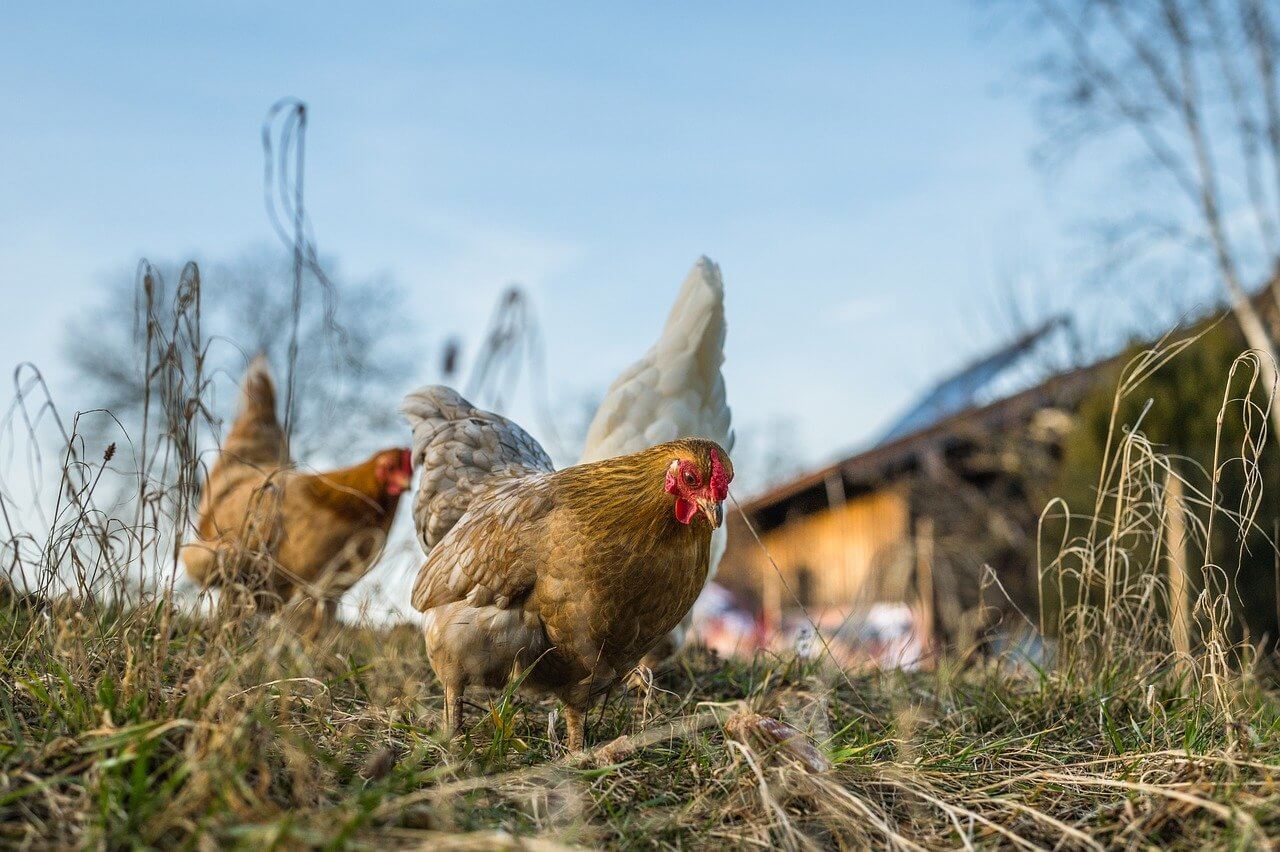Many breeds of chicken can tolerate cold winter weather with no problems. For most, it isn’t necessary to artificially heat the coop unless you get really sub-zero conditions. In this article, we will be looking at how to keep chickens warm in winter without electricity.
What You'll Learn Today
What Temperature is too Cold for Chickens?

Unlike people, chickens have fantastic feathers, which they can fluff up to keep them cozy and warm. They act like the chickens own super warm quilts.
The question of what temperature is too cold for a chicken depends greatly on the breed of the chicken. Birds that originate in the cooler parts of Europe, I’m talking temperature here, not nightlife can generally tolerate icy climates compared to birds from Asia.
Providing your chickens have a cozy coop to shelter in and get out of cold draughts, they can tolerate quite large extremes in temperature.
Think about wild birds, even tiny ones are capable of surviving very harsh winters, and chickens are no different except they are lucky enough to have us to care for them. Even if it’s -10° below with good food and shelter they should be alright.
Can Chickens Survive Winter Without Heat?
We tend to humanize our animals and think they feel the same things we do. But this isn’t really the case.
Having a well-built coop that is free from draughts, insulated, watertight, and contains roosts so your birds can get off the cold floor, all help them survive well in winter without the need of an additional heat source.
One thing people sometimes overlook when making a coop warm is maintaining good ventilation. This is of critical importance to the health of your hens.
To test if a chicken is warm, all you have to do is put your hand under its wing. You should find it is quite toasty even on the coldest of nights.
Chicken feathers are exceptionally good at trapping warm air and when cold you’ll find your birds huddling together to make use of each other’s body heat.
How to Keep Chickens Warm in Winter Without Electricity?

It can be a mistake to put electric heat lamps into coops during the winter. There are several reasons why it is not a good idea:
- Chickens can become reliant on the heat
- If the bulb blows without you knowing, the chickens can become chilled
- The lamps are a fire hazard
- They cost money to run
Wet Weather
It isn’t the cold that is your bird’s enemy, it is the combination of wet and cold. If your chickens have dense loose feathers that are great for keeping out the cold, they may also be quite absorbent and act as a sponge to hold moisture in.
If your birds get soaked during the day and then very cold at night, they have no way to warm up. They are reliant on their feathers being dry so they can trap warm air coming from the heat generated by their bodies.
This means one of the most important ways to keep your chickens warm in winter without electricity is by making sure they stay dry.
I use transparent, corrugated roofing sheets on my chicken run during the winter. This helps to keep the majority of the rain out while letting sunlight in.
Drafts
When you’re sitting still in a cold draft, you get cold very quickly. The same is true for a chicken. When they’re roosting at night, they need to be protected from drafts.
Look for any gaps in your coop that may allow drafts in especially at the height your chickens will be roosting. Fill or cover the holes so no air can get through them.
Around doors is a very common place for drafts to enter. You can make a simple internal frame that the door closes firmly onto to prevent this.
This doesn’t mean you hermetically seal every air inlet/outlet in your coop, as ventilation is also essential.
Ventilation
Good ventilation is extremely important in your coop, and although it won’t keep your hens any warmer, it will help to keep them healthy whatever the weather.
Hot air is lighter than cold air, so the warmer air rises while cold air sinks. This is one of the reasons why you need to have perches where your birds can roost at night off of the floor.
The hot, stale air contains carbon dioxide and ammonia, which can damage your chicken’s lungs, it needs somewhere to escape even in winter.
This video shows how soffit and ridge vents work together to bring good airflow without drafts.
All vents should have a small gauge wire mesh over them to stop the ingress of wild birds or rodents into the coop.
Feed
In winter, chickens should be fed a supplemental diet that is higher in carbohydrates and oils such as corn and cooked soybeans. If given in the late afternoon this helps them build a good layer of fat and increases their metabolism.
Don’t forget to take out any uneaten feed at the end of the day to avoid attracting rodents.
How to Heat a Chicken Coop Without Electricity?

It is mostly advisable not to heat your coop artificially as it can cause more problems than it solves. Having cold hardy chicken breeds is a better solution.
Solar Heater
If you live in a particularly cold environment, then it is possible to get solar-powered heaters to use in your coop.
The warmth they provide is zonal, just like with a heat lamp. Other ways to build and maintain a reasonable temperature may be a better solution.
Deep Litter
A good way of maintaining warmth in your coop is by using a deep litter system. Rather than taking out all of your chicken’s bedding when cleaning your coop, you leave it in place. This way it starts to naturally decompose and, in so doing, creates heat.
All you have to do is add a regular fresh layer of pine shaving on the top. Don’t use straw as it can harbor lice and mites.
Be careful about the shavings you use, as some types of wood are toxic to chickens and could make them sick. Cedarwood is an example of this.
Good ventilation is needed if you’re going to use deep litter.
Sunlight
Although the sun may shine less brightly in the winter months, it is still warm and can help to trap heat in the coop. To do this, you need well-insulated windows that you can open in the summer months for added ventilation.
Having shutters that close over the windows in very hot weather or at night in winter is a good idea too.
If your coop is well insulated, once the heat comes in through the windows, it will help to warm the interior.
Large coops with dark solid floors such as concrete, stone, or limecrete can absorb heat and release it again slowly during the night.
Insulation
One of the most effective ways to maintain warmth in your coop during the winter is good insulation. There are a variety of things you can use to effectively insulate your coop including:
Rolls of House Insulation – Rolls of insulation used in roof spaces and walls of homes, can also be used to insulate a coop. Be aware that some are pretty nasty, and you certainly don’t want your birds getting at the stuff or breathing in the dust it creates. For this reason, you’ll need to sandwich it between two layers (like stud walls). Plywood is an effective covering that can be used to keep it away from your birds. The biggest downside to this form of insulation is the cost.
Shredded Paper – Something as simple as shredded paper or ripped-up newspaper stuffed into a cavity wall is a good insulator. It’s very inexpensive or even free if you can source some old newspapers.
Styrofoam – Many things, particularly electrical goods come packed in Styrofoam. You can use this to put between stud walls or in the ceiling of your coop to act as insulation.
You’ll need to ensure your birds can’t peck at it, as it won’t do much for their health, but it is a good way of recycling a waste product and putting it to good use.
Cardboard – Old boxes flattened down, or cartons can be used. Simply tape them to the walls or ceiling of your coop. They generally don’t last too long, so they would need replacing at least each fall.
Fabric – Unwanted bed covers, table cloths even clothes cut into rags can be used as insulation. For a very inexpensive fix, you could cover it with cardboard to make a nice insulating sandwich.
Which Chicken Breeds are Best for Cold Climates?
Chickens that can cope best with cold weather conditions are those with small combs and wattle, dense feathering, and heavy bodies. Choosing breeds that originated in colder places is also a sensible idea.
Some of the best breeds for cold climates are:
- Canadian Chantecler
- Welsummer
- Wyandotte
- Dominique
- Buff Orpington
- Rhode Island Red
Conclusion
Chickens can stand cold weather conditions without too much trouble, providing they stay protected from the wet, cold, and wind.
Even if your coop has no form of heating, provided it is insulated, and you give high energy feed, your birds should do just fine.
Without heating seems not an option for my farm as we live far in the North of the country.